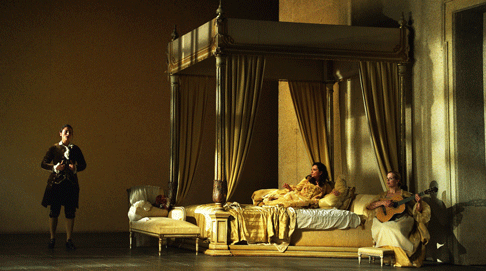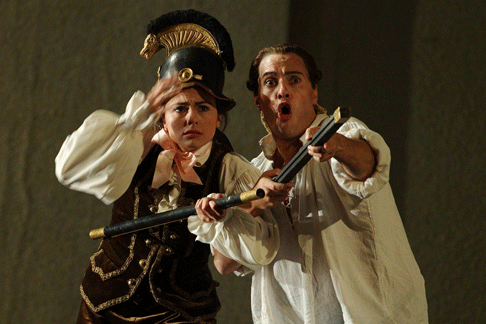30 May 2011
Les Noces de Figaro in Paris
This is the one by Giorgio Strehler that opened at Versailles in 1973 and since has endured twenty-three incarnations, first at the Garnier and later at the Bastille.

This is the one by Giorgio Strehler that opened at Versailles in 1973 and since has endured twenty-three incarnations, first at the Garnier and later at the Bastille.
Anyone who is anyone in the pantheon of Mozart interpreters over the last forty years has gone through the paces of this Strehler masterpiece.
It did have a brief respite during the Gerard Mortier five year reign of terror. To everyone's relief it is back now ostensibly as a tribute to Rolf Liebermann (the celebrated progressive impresario who succeeded in staying in conservative Paris for seven years in the nineteen-seventies) but actuality it is an appeasement to Parisian audiences for whom it has become, purely and simply, the Mozart masterpiece.
Based on its current edition at the Bastille it is a Marriage of Figaro none of us should go without. Not to worry if you have missed it so far. It will surely be back, and with whoever are the stars of the moment. The Strehler Noces is as Parisian as is, well, the Opéra or for that matter the Tour Eiffel. It is the embodiment of the elegance, refinement and grace that define La Ville-Lumière.
Its roots are in mannerisms, the little movements of physical comedy that were sculpted by the comedians of the Italian renaissance, then refined by Italy's eighteenth century dramatists, and finally distilled by Giorgio Strehler. It is like the theatrics of the French royal courts that have become elaborated over the centuries into French politesse, haute couture, cuisine, etc. Simply to say that the ultra controlled, hyper refined theatrics of Giorgio Strehler very well mirror an idealized French spirit.
Though strange to say it was the musical refinement of the current production that very nearly upstaged the Strehler elegance. Israeli conductor Dan Ettinger unleashed the lyricism Mozart lavished on the individual instruments of the orchestra that brought this familiar music to new plateaux of delicate pleasures. The horn duet in Se vuol ballare, the oboe solo in Dove sono, the resonant pizzicato strings in Deh vieni leap out as examples, but the overwhelming orchestral lyricism was everywhere and always.
The cast was perfection. The program bio of Uruguayan bass Erwin Schrott unabashedly declares him to be the Figaro of the moment, a claim well proven by his distinctive dark voice, physical agility and sympathetic authority. His nearly speech-like delivery of recitative was remarkable. The Susanna of German soprano Julia Kleiter was physically, even vocally well matched to the Countess of German soprano Dorothea Röschmann to make Strehler's very presentational staging of the disguises far less tiresome than usual.
Both sopranos are no-nonsense artists, penetrating the heart of the music and letting it naturally flow to the obvious great pleasure of the maestro who melted Mozart's eloquent orchestra to their voices. It was extraordinary music making. British baritone Christopher Maltman brought bark and bite and unusual fun to the Count, plus new, sly insight into his often tiresome aria that perceptibly deepened his character and enlivened the denouement of Figaro's financial predicament.

American mezzo Isabel Leonard may now compete with Federica von Stade as the Cherubino of your dreams, combining easy postures with consummate charm, upholding the impeccable musicianship that validates this travesty. The there-can-be-no-opera-in-Paris-without corps de ballet crashed the wedding scene, and the intrusion only gained validity when Mlle. Leonard leapt into the balletic fray with a virtuostic display of dance that conclusively proved her manhood (one did wonder how la Von Stade and all the others pulled this scene off).
The Marcellina of British mezzo/comedienne Ann Murray was exemplary. The Bartolo of Maurizio Muraro and the Basilio of Robin Leggate were rendered less present than usual in this production by the persuasive musicality of the five principals.
The extant members of the original production team were said to be involved in mounting this latest incarnation — Ezio Frigerio (sets and costumes), Franca Squarciapino (costumes), Marise Flach (movement). The actual credit for this and perhaps many other incarnations of the Strehler Noces belongs to Humbert Camerlo, an original member of the Libermann directorial staff who will have adapted the individual personalities of its current interpreters to the original Strehler conception.
Michael Milenski
